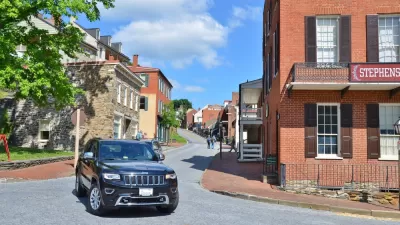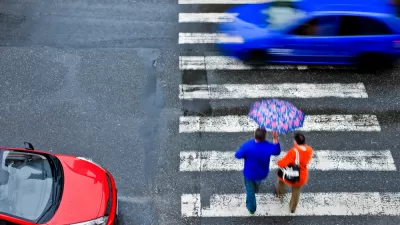While much focus is on the future of autonomous vehicles, the increase in pedestrian deaths related to SUVs remains a largely ignored issue.

Recent debates about self-driving vehicles and public safety have overshadowed the long-standing issue of SUVs, writes Henry Grabar. The overall number of traffic fatalities decreased in 2018, but pedestrian and cyclist deaths are on the rise. More SUVs are on the road, and that is part of the problem, says Grabar:
In February, the Governors Highway Safety Association estimated that more than 6,200 pedestrians died in 2018—the highest number in a generation, and an increase of 50 percent from 2009. The GHSA says SUVs are partially responsible: Their involvement in fatal crashes is up 50 percent, compared with 30 percent for sedans.
The National Highway Traffic Safety Administration has known for years that the weight, higher bumpers, and limited visibility of SUVs mean pedestrians are more likely to be killed when struck by the vehicles. "The regulators did nothing. If another product saw its nonuser death count spike by 50 percent in 10 years, consumers would revolt and Congress would make a big show of getting to the bottom of it. Automobiles are different," argues Grabar.
Regulation in Europe—where SUV sales are up, but pedestrian deaths decreased by over a third between 2007 and 2016— could provide some clues for the U.S., notes Grabar. Safety assessments of European vehicles include a "vulnerable road users" criterion. "In America, by contrast, NHTSA ratings have three primary categories: frontal crash, side crash, and rollover. What happens to the people you hit? Who knows."
FULL STORY: Don’t Count on U.S. Regulators to Make Self-Driving Cars Safe for Pedestrians

Study: Maui’s Plan to Convert Vacation Rentals to Long-Term Housing Could Cause Nearly $1 Billion Economic Loss
The plan would reduce visitor accommodation by 25,% resulting in 1,900 jobs lost.

North Texas Transit Leaders Tout Benefits of TOD for Growing Region
At a summit focused on transit-oriented development, policymakers discussed how North Texas’ expanded light rail system can serve as a tool for economic growth.

Using Old Oil and Gas Wells for Green Energy Storage
Penn State researchers have found that repurposing abandoned oil and gas wells for geothermal-assisted compressed-air energy storage can boost efficiency, reduce environmental risks, and support clean energy and job transitions.

Santa Barbara Could Build Housing on County Land
County supervisors moved forward a proposal to build workforce housing on two county-owned parcels.

San Mateo Formally Opposes Freeway Project
The city council will send a letter to Caltrans urging the agency to reconsider a plan to expand the 101 through the city of San Mateo.

A Bronx Community Fights to Have its Voice Heard
After organizing and giving input for decades, the community around the Kingsbridge Armory might actually see it redeveloped — and they want to continue to have a say in how it goes.
Urban Design for Planners 1: Software Tools
This six-course series explores essential urban design concepts using open source software and equips planners with the tools they need to participate fully in the urban design process.
Planning for Universal Design
Learn the tools for implementing Universal Design in planning regulations.
Ascent Environmental
Borough of Carlisle
Institute for Housing and Urban Development Studies (IHS)
City of Grandview
Harvard GSD Executive Education
Toledo-Lucas County Plan Commissions
Salt Lake City
NYU Wagner Graduate School of Public Service





























